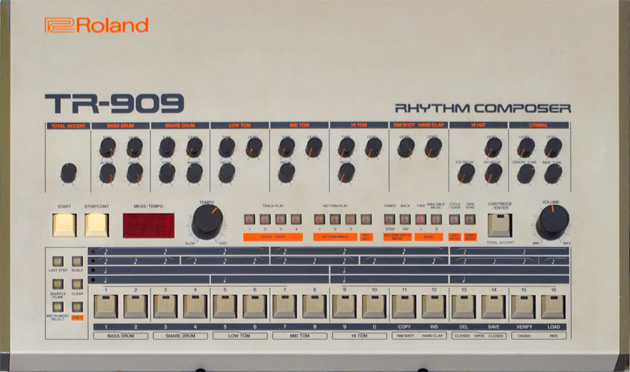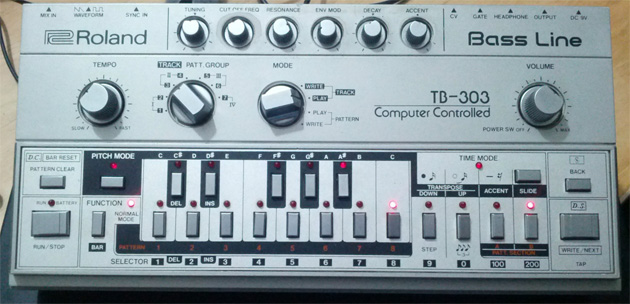There’s too much to say about the three most definitive drum machines – the Roland TR-808, TR-909, and TB-303 – to condense into an hour. That’s not to say Kutski, the host of BBC Radio 1’s Stories: 808s, 303s and 909s, doesn’t attempt to. Although scatterbrained and going off on tangents at times, Kutski’s efforts to track down the team who built these machines and to determine why producers continue to go back to their sounds eventually pay off, inform the listener without using too much techno-babble, and involve decent interviews with DJ Premier, Richie Hawtin, A Guy Called Gerald, Alex Metric, Evil Activities, and Pete Tong along the way.
First-hand accounts of the 808, 909, and 303 (in that order) are essentially what make this BBC Radio 1’s Stories program worthwhile. Hip-hop, house, and techno producers all recount how they came across the devices and sounds. Perhaps the most notable is Richie Hawtin’s. The producer occasionally going by the name Plastikman revealed the 303 was the first to draw him in, primarily because of its inclusion on Derrick May records in the 1980s, and for the snare, the 808 later became his drum machine of choice. Rather than reminisce solely about Chicago house and Detroit percussive music, Hawtin relates these earlier devices to the present, giving a shout out to artists like Nicky Romero.
Essentially, the personal accounts and observations form a loose history around these drum machines, one in which the beginning is revealed at the end (Kutski finally talks to Roland TR-808 developer Don Lewis in the last 10 minutes) and its integral role in hip-hop, house, techno, and even trap is explored. What’s particularly interesting is how the artists and producers consider these three devices as instruments, rather than simply machines. Although, it’s revealed, the 303 was originally intended to be used as a bass synthesizer, the 808 is compared to the Fender Stratocaster and Les Paul at one point and, within the context of hip-hop, considered a better alternative to the drum set.
Complementing each interview and running through the background is a wide array of tracks, each displaying a facet or sound quality that can be produced. The first half of the program gave more attention to hip-hop, transitioned through quintessential (and now overexposed) trap track “Harlem Shake,” and went through over 20 years of house and techno: The 2Bears “Bear Hug,” Cybotron “Clear,” Toddla T “Take It Back” (2Bears Remix), S’Express “Theme From S-Express,” Underworld “Born Slippy,” Plastikman “Spastik,” Nicky Romero “Generation303,” 808 State “Pacific State,” A Guy Called Gerald “Voodoo Ray,” and Phuture “Acid Trax,” to name some of the highlights.
Despite the many positive qualities, 808s, 303s and 909s has some significant drawbacks, ones exposing the fact that it’s just an hour-long radio program and not a fleshed-out documentary. Midway through, Kutski reveals Lewis hasn’t answered his email (wasn’t this essentially part of the show’s point?), although the Roland developer comes through with less than 15 minutes left. Lewis’ account sheds some light onto the 808’s history: Mainly, that no one really cared about the drum machine until hip-hop artists and, later in the 1980s, house and techno producers picked it up.
Although Lewis’ story is one of the most definitive of the hour, others are less so. Kutski brought on other Radio 1 and 1Xtra DJs, but who’s speaking isn’t always clear. Anecdotes, as well, don’t always lead to a conclusion. For instance, A Guy Called Gerald goes on a bit too long about a found Roland MC-202 getting fixed up by a couple of Polish guys.
Ultimately, while the history component is explained as thoroughly as it can be in an hour, the “why” component is a string going through each producer’s story, with all, save for Tong’s observations, leading to the same conclusion: Producers associate these songs with high-quality and classic dance music tunes, so going back to them seems natural. Tong, on the other hand, raises a point that isn’t explored thoroughly and could be an explanation for why modern EDM has taken on the form it has: producers still sample these sounds and add them through Logic, but these default tones are no longer used the way they used to be. What could’ve been a crucial point to explore is simply the end to another observation: that purchasing software is far more affordable than hunting down these relics of a definitive era.







